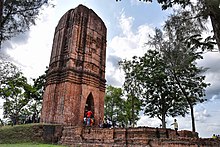Jatar Deul
| Jatar Deul | |
|---|---|
 | |
| Religion | |
| Affiliation | Hinduism |
| Deity | Shiva |
| Location | |
| Location | Kankan Dighi/Jata South 24 Parganas |
| State | West Bengal |
| Country | India |
| Geographic coordinates | 21°59′33″N 88°29′15″E / 21.99250°N 88.48750°E |
| Architecture | |
| Type | Rekha deul |
| Date established | 10th -11th century |
| Completed | 10th -11th century |
| Elevation | 30 m (98 ft) |
Jatar Deul is located in district South 24 Parganas of the Indian state West Bengal.[1][2] This is a brick temple and is datable between the 10th and 11th century on the basis of its architecture.[1] However, this type of brick temple we can see at Nebia Khera, Uttar Pradesh.[3]
Location
The Jatar-Deul stands isolated on a small hill in the surroundings of the locality Kanakan Dighi, about 5 km east of the small town of Raidighi in the Mathurapur II community development block in the Diamond Harbour subdivision of the district of South 24 Parganas in West Bengal.[4]
History

The temple is known by the name of "Jatar Deul ".[5] This brick temple is traditionally connected with an inscription (not traceable now) of one Raja Jayantachandra, purported to have been issued in 975 AD.[1] It was probably dedicated to Mahadev or Siva, who also goes by the name of Jatadhari.[5] The Archaeological Department board at the temple site places establishment around 11th century.[4] However, there was no deity inside the temple.[1] The discovery of Jatar Deul dates back to the middle of the nineteenth century, when land surveyors stumbled upon a towering brick structure in the midst of the Sundarban.[4]
Consecration
What purpose it served is now a matter of conjecture.[6] There is neither a cult nor any other sculptural or inscriptional evidence available, it is also the consecration of the temple is unclear – some believe it was originally for a Buddhist structure; others see it as a building in honor of the Hindu God Shiva (Mahadev).[7]
Architecture
It towers nearly 100 ft. above the plain.[8] The entrance which is on the east is 9.5 ft. wide and is spanned by a pointed arch.[8] The inside is about 10 ft. square and the walls are about 10 ft. thick.[8] No plinth is visible and the floor is some six feet below the ground, and is reached by a flight of steps.[8]
According to the List of Monuments of National Importance in West Bengal Jatar Deul is an ASI listed monument.[2]
References
- ^ a b c d "ASI, Kolkata Circle".
- ^ a b "List of Ancient Monuments and Archaeological Sites and Remains of West Bengal - Archaeological Survey of India". Item no. 6. ASI. Retrieved 25 January 2020.
- ^ "On a trail to explore stories behind brick temples". The Times of India. The Times Group. 4 March 2018. Retrieved 9 November 2023.
- ^ a b c Datta, Rangan. "Jatar Deul horse race: Inexperienced riders, uneven tracks and unbridled fun". Retrieved 21 April 2022.
- ^ a b "List of Ancient Monuments in Bengal".
- ^ "Monographs of the Varendra Research Society no. 3 by Majumdar N.G."
- ^ Ghosh, Binoy, Paschim Banger Sanskriti, (in Bengali), part III, 1980 edition, pages 152-155, Prakash Bhaban, Kolkata
- ^ a b c d "Monographs of the Varendra Research Society no. 3, by Majumdar N.G."



